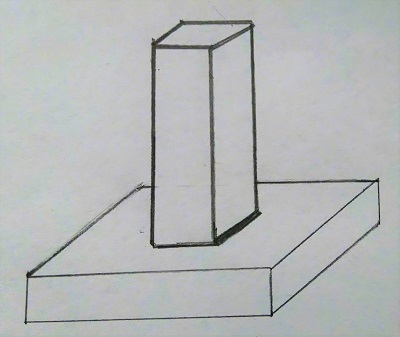Pad foundation
Foundations provide support for structures, transferring their load to layers of soil or rock that have sufficient bearing capacity and suitable settlement characteristics. They can be used to help to prevent settlement and other movements of structures and can permit construction on ground that might otherwise have insufficient bearing capacity.
There are a very wide range of foundation types suitable for different applications, depending on considerations, for example:
- The nature of the load requiring support.
- Ground conditions.
- The presence of water.
- Accessibility.
- Sensitivity to noise and vibration.
- Proximity to other structures and loading
- Project time-frames.
Very broadly, foundations can be categorised as shallow foundations or deep foundations. Shallow foundations are typically used where the loads imposed by a structure are low relative to the bearing capacity of the surface soils. Deep foundations (more than 3 m from the surface) may be necessary where the bearing capacity of the surface soils is insufficient to support loads imposed.
Pad foundations are generally shallow foundations, but can be deep depending on the ground conditions. They are a form of spread foundation formed by rectangular, square, or sometimes circular concrete ‘pads’ that support localised single-point loads such as structural columns, groups of columns or framed structures. This load is then spread by the pad to the bearing layer of soil or rock below. Pad foundations can also be used to support ground beams.
They are generally of a uniform thickness, but sometimes the upper face may be sloped or stepped. Their plan shape will depend on the nature of the applied load and the allowable bearing capacity of the layers below. Their thickness must be sufficient to distribute the load across the plan shape. They are generally reinforced on all but the smallest structures, with the reinforcement allowing higher loads to be imposed and the construction of shallower pads which require less excavation and use less concrete.
The arrangement of pad foundations will vary depending on the nature of the structure they are supporting, the loads imposed, the allowable bearing capacity of the layers below and the space available on site. They may be:
- A series of discrete, well-separated pads.
- Balanced base pads that support more than one point load.
- Continuous pads, where there are a number of point loads close together.
- Pad and beam, where a series of pads support a continuous beam.
Pad foundations can be selected as they do not require much excavation, and are generally suitable where the bearing capacity of ground is sufficient at relatively low depths. However, they can be large in plan shape and may not be effective against differential settlement, uplift forces or wind forces.
See also: How to design pad foundations.
See also: Types of pad foundation.
NB High Speed Rail (Crewe – Manchester) Environmental Statement, Glossary, abbreviations and references, published by the Department for Transport in 2022, defines pad foundations as: ‘A foundation structure that spreads the imposed loads over a sufficient area to reduce stress on foundation material. Often described as shallow foundations.’
[edit] Related articles on Designing Buildings
- Compensated foundation.
- Continuous flight auger piles.
- Driven piles.
- Footings.
- Foundations.
- Geothermal pile foundations.
- Ground anchor.
- Groundworks.
- How deep should foundations be?
- How to design a pad foundation.
- Micropiles.
- Padstone.
- Piers.
- Pile foundations.
- Raft foundation.
- Screw piles.
- Slab.
- Strip foundation.
- Temporary works.
- Trench fill foundation.
- Types of pad foundation.
- Types of raft foundation
IHBC NewsBlog
SAVE celebrates 50 years of campaigning 1975-2025
SAVE Britain’s Heritage has announced events across the country to celebrate bringing new life to remarkable buildings.
IHBC Annual School 2025 - Shrewsbury 12-14 June
Themed Heritage in Context – Value: Plan: Change, join in-person or online.
200th Anniversary Celebration of the Modern Railway Planned
The Stockton & Darlington Railway opened on September 27, 1825.
Competence Framework Launched for Sustainability in the Built Environment
The Construction Industry Council (CIC) and the Edge have jointly published the framework.
Historic England Launches Wellbeing Strategy for Heritage
Whether through visiting, volunteering, learning or creative practice, engaging with heritage can strengthen confidence, resilience, hope and social connections.
National Trust for Canada’s Review of 2024
Great Saves & Worst Losses Highlighted
IHBC's SelfStarter Website Undergoes Refresh
New updates and resources for emerging conservation professionals.
‘Behind the Scenes’ podcast on St. Pauls Cathedral Published
Experience the inside track on one of the world’s best known places of worship and visitor attractions.
National Audit Office (NAO) says Government building maintenance backlog is at least £49 billion
The public spending watchdog will need to consider the best way to manage its assets to bring property condition to a satisfactory level.
IHBC Publishes C182 focused on Heating and Ventilation
The latest issue of Context explores sustainable heating for listed buildings and more.

















Comments
[edit] To make a comment about this article, click 'Add a comment' above. Separate your comments from any existing comments by inserting a horizontal line.